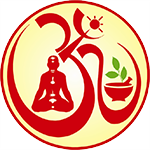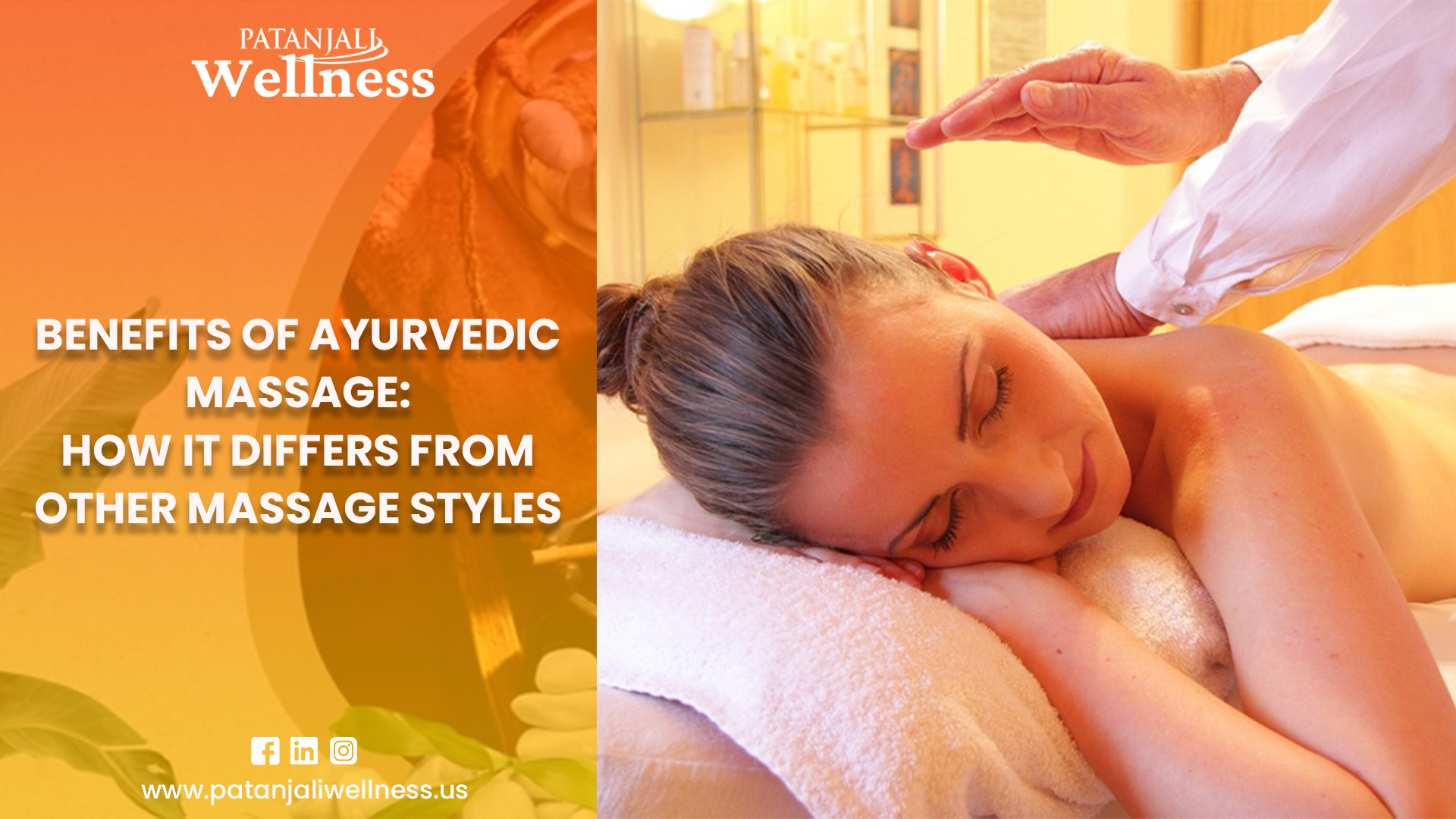Relaxation is the first thing that comes to mind when we hear the word massage. There are a variety of massage techniques that rejuvenate the mind, body, and spirit. According to Ayurveda, body pains and stiffness are the result of energy blockages in the veins, which can be eliminated through daily massage. Regular Ayurvedic massages relax the entire body because they promote digestion, appetite, sleep, blood circulation, and skin health.
What is Ayurvedic Massage?
Ayurvedic massage is an ancient form of massage that originated in India almost 5,000 years ago. It focuses on relaxing the body, mind, and soul for overall health and well-being.
Ayurvedic massage, also known as Abhyanga, is a technique where various herbs and oils are used. It involves using multiple oils and strategies tailored to an individual’s specific constitution, or dosha, determined through an Ayurvedic assessment. There are three primary doshas in Ayurveda: Vata, Pitta, and Kapha, and the massage is customized to balance the recipient’s doshic imbalances.
History of Ayurvedic Massage
As we have mentioned above, Ayurveda, an ancient form of medicine that was introduced thousands of years ago in India, means ‘science of life’ according to Sanskrit. Here is an overview of Ayurvedic massage in-depth:
Ancient Origins
Ayurveda and Ayurvedic massage have their origins in the Vedas, the ancient Indian scriptures, specifically the Atharva Veda. The Vedas contain some of the earliest references to healing practices, medicinal flora, and the maintenance of a healthy body’s balance.
Development of Ayurveda
Over time, Ayurveda evolved into a comprehensive system of medicine focusing on maintaining balance among the three doshas (Vata, Pitta, and Kapha), understanding the body’s constitution, and using various therapies to promote health.
Ayurvedic Texts
The foundational texts of Ayurveda, including the Charaka Samhita and the Sushruta Samhita, were written between the 6th century BCE and the 6th century CE. These texts provide detailed descriptions of Ayurvedic principles, treatments, and therapies, including the practice of Abhyanga.
Ayurvedic Massage in Ancient India
Abhyanga has been practiced in India for centuries as a form of preventive healthcare and a way to address various health concerns. It was used not only for physical health but also for mental and emotional well-being.
Traditional Techniques and Oils
Ayurvedic massage traditionally involves using specific oils and techniques tailored to an individual’s dosha and constitution. Different oils and herbs address particular health issues, and the massage techniques are designed to balance the doshas.
Revival and Modernization
In the 20th century, there was a renewed interest in Ayurveda and Ayurvedic massage, both in India and internationally. This led to the modernization and standardization of Ayurvedic massage techniques, making them more accessible to a global audience.
Contemporary Practice
Today, Ayurvedic massage is widely practiced in India and is gaining popularity in other parts of the world. It is often offered at Ayurvedic wellness centers, spas, and by certified practitioners who have received training in Ayurvedic massage techniques.
Ayurvedic massage has a long and enduring history in India and is an essential aspect of Ayurveda’s holistic approach to health and well-being. It is considered not only a therapeutic practice but also a means of promoting relaxation, rejuvenation, and the maintenance of overall health.
The benefits of Ayurveda massage
Ayurvedic massage, also known as Abhyanga, offers a wide range of potential benefits, as it is tailored to an individual’s specific constitution and health needs. The benefits can vary depending on the type of oils and techniques used, the person’s dosha (Vata, Pitta, or Kapha), and the intention behind the massage. Here are some of the common benefits associated with Ayurvedic massage:
- Relaxation and Stress Reduction: Ayurvedic massage is known for its calming and soothing effect. It helps relax the muscles, calm the nervous system, and reduce stress and anxiety. The use of warm herbal oils and gentle strokes enhances the overall sense of relaxation.
- Improved Circulation: The massage techniques used in Ayurveda help stimulate blood flow and lymphatic circulation, which can lead to better oxygenation of tissues and the removal of toxins from the body.
- Balancing Doshas: Ayurvedic massage is customized to balance the recipient’s doshas. Depending on your dominant dosha, the massage can help bring your constitution into equilibrium. For example, Vata-pacifying massages are grounding and stabilizing, while Pitta-pacifying massages are cooling and soothing.
- Detoxification: The warm herbal oils used in Abhyanga are believed to help release toxins from the body and improve energy flow (prana). This can aid in the detoxification process.
- Pain Relief: Ayurvedic massage can relieve various types of pain, including muscle and joint pain. The massage techniques, when applied skillfully, can help reduce discomfort and tension.
- Improved Skin Health: The oils used in Ayurvedic massage can improve skin health by nourishing and hydrating the skin. This can lead to a healthier complexion and a more youthful appearance.
- Enhanced Sleep Quality: Many individuals report better sleep quality after receiving an Ayurvedic massage. The relaxation and stress reduction it provides can contribute to improved sleep patterns.
- Increased Energy Levels: For some, Ayurvedic massage can boost energy levels by balancing the doshas and improving overall vitality.
- Emotional Well-Being: Ayurvedic massage is not just physical; it also addresses mental and emotional well-being. It can help reduce emotional imbalances and promote a sense of inner peace.
- Immune System Support: Some Ayurvedic oils and herbs used in the massage are believed to have immune-boosting properties, which can help the body’s natural defenses.
- Muscle and Joint Health: The techniques used in Abhyanga can improve flexibility, reduce muscle stiffness, and promote joint health.
- Enhanced Digestion: Ayurvedic massage may support digestive health by reducing stress and improving overall relaxation.
It’s important to note that the specific benefits of Ayurvedic massage can vary from person to person, depending on their unique constitution and health goals. To experience the full benefits of Ayurvedic massage, it is recommended to consult with a qualified Ayurvedic practitioner or therapist who can tailor the treatment to your individual needs and provide a personalized approach to your well-being.
Difference Between Ayurvedic Massage & Other Massage Styles
Ayurvedic Massage is a specific type of massage that originated in India and is based on the principles of Ayurveda, a traditional holistic healing system. Here are some key differences between Ayurvedic Massage and other massage styles:
- Techniques: Ayurvedic Massage incorporates a variety of methods, such as kneading, tapping, and squeezing, along with oils and herbal preparations. Other massage styles may focus on specific techniques like Swedish, deep tissue, or sports massage, which may or may not involve using oils.
- Philosophy: Ayurvedic Massage aims to balance the body, mind, and spirit by working on the energy channels and specific points on the body known as marma points. It focuses on harmonizing the doshas (energetic forces) within the body. Other massage styles may focus on relieving muscle tension, promoting relaxation, or addressing specific physical issues.
- Herbal Preparations: Ayurvedic massage frequently employs warm herbal oils or granules tailored to the dosha or body type of the recipient. It is believed that these herbal preparations have therapeutic properties and can enhance the benefits of massage. Herbal preparations are typically not incorporated into other types of massage.
- Customization: Ayurvedic massage is highly individualized and takes into account an individual’s unique body type, imbalances, and health conditions. Depending on these variables, massage techniques and lubricants may vary. Other massage techniques may have a more standardized approach that disregards individual differences.
- Focus on Energy Channels: Ayurvedic massage devotes particular attention to the energy channels (nadis) and marma points. By stimulating these points, the objective is to enhance energy flow and promote general health. Other massage techniques may need to specifically target these energy channels.
- Ayurvedic Consultation: A consultation with an experienced Ayurvedic practitioner is typically indicated prior to receiving an Ayurvedic massage. This enables the therapist to comprehend the client’s constitution and health condition in order to provide a customized massage. Other massage techniques typically do not require a consultation prior to the massage.
It’s important to note that while Ayurvedic Massage has unique characteristics, other massage styles also offer their benefits. The choice of massage style ultimately depends on individual preferences, health needs, and desired outcomes.
Types of Ayurvedic Massage
Various types of Ayurvedic massage employ various techniques and concentrate on various aspects of health. Here are some prevalent Ayurvedic massage types:
- Abhyanga: Abhyanga is the most prominent and widely used Ayurvedic massage technique. Applying warm herbal oil all over the body and then using firm to delicate strokes are involved. Abhyanga assists in the balancing of the doshas, enhances circulation, promotes relaxation, and nourishes the epidermis.
- Shirodhara: Shirodhara is a unique Ayurvedic therapy in which warm oil is poured over the forehead in a slow and constant stream. This treatment targets the mind and nervous system specifically, inducing profound relaxation, relieving stress, and fostering mental clarity.
- Panchakarma: Panchakarma is a comprehensive Ayurvedic detoxification and rejuvenation program. It consists of multiple treatments, including Abhyanga, Snehana (oleation), Swedana (herbal steam therapy), Vamana (therapeutic vomiting), Virechana (purgation), Basti (enema), and Nasya (nasal administration of medicated oils or powders). Panchakarma aims to eliminate toxins, restore balance, and enhance overall well-being.
- Udvartana: Udvartana involves vigorously applying a medicinal herb paste or flour to the entire body. This massage is beneficial for weight loss, improved circulation, lymphatic flow stimulation, and skin exfoliation.
- Garshana: Garshana is a dry massage performed without the use of oil. It utilizes raw silk gloves or specialized brushes to stimulate the lymphatic system, improve circulation, and exfoliate the skin. This massage is often performed as a prelude to other Ayurvedic treatments to enhance their effectiveness.
- Marma Massage: Marma points are vital energy points located throughout the body. Marma massage involves gentle pressure and stimulation of these points to balance energy flow, release blockages, and promote overall well-being.
These are just a few examples of Ayurvedic massage techniques. Each type of massage offers specific benefits and addresses different aspects of mind-body wellness. It is advisable to consult with an experienced Ayurvedic practitioner to determine the most suitable massage type for your particular needs and health conditions.
We hope that this information helps you before planning for an Ayurvedic massage. If you still have any concerns, then contact us today!





